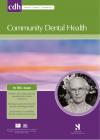Community Dental Health

- Cover Date:
- December 2011
- Print ISSN:
- 0265 539X
- Vol:
- 28
- Issue:
- 4
Predictors of utilisation of dental care services in a nationally representative sample of adults
Objective: The objective of this study was to identify the predictors of utilisation of dental care services in Ireland. Participants: The 2007 Irish Survey of Lifestyle, Attitudes and Nutrition is a cross-sectional study, conducted in 2006/2007 (n=10,364), by interviews at home to a representative sample of adults aged 18 years or over. Main outcome measures: Multivariate logistic regression was used to investigate the influence of socioeconomic, predisposing and enabling factors on the odds of males and females having a dental visit in the past year. Results: The significant predictors of visiting the dentist in the past year were for males: having 3rd level education, employment status, earning €50,000 or more, location of residence, use of a car, brushing frequently, and dentition status. For females, the predictors were being between 25-34 or 55-64 years-old, education level, earning €50,000 or more, location of residence, use of a car, brushing frequently and dentition status. Conclusions: Predictors of the use of dental services vary by gender. Predictors common to both genders were education level, higher income, location of residence, use of a car, brushing frequently and dentition status. Many of the predictors of dental visiting in the past year are also related to social inequalities in health. These predictors may be useful markers of impact for policies designed to address inequalities in access to oral health services.
Key words: utilisation of dental services, dental health, adults, frequent brushing, socioeconomic status, income, education, gender, enabling factors, predisposing factors
- Article Price
- £15.00
- Institution Article Price
- £
- Page Start
- 269
- Page End
- 273
- Authors
- H. Guiney, N. Woods, H. Whelton, K. Morgan
Articles from this issue
- Title
- Pg. Start
- Pg. End
- Why has oral health promotion and prevention failed children requiring general anaesthesia for dental extractions?
- 255
- 258
- Predictors of utilisation of dental care services in a nationally representative sample of adults
- 269
- 273
- Applicability of both dentist and patient perceptions of dentists’ explanations to the evaluation of dentist–patient communication
- 274
- 279
- Evaluation of a preventive program based on caries risk among mentally challenged children using the Cariogram model
- 286
- 291
- The effect of a modified fluoride toothpaste technique on buccal enamel caries in adults with high caries prevalence: a 2-year clinical trial
- 292
- 296
- Association of clinical oral health status with self-rated oral health and GOHAI in Japanese adults
- 297
- 300
- Prevalence of periodontopathogens in a black Brazilian secluded community matched with a black urban population
- 301
- 304
- Incisor trauma in a Turkish preschool population: Prevalence and socio-economic risk factors
- 308
- 312
- Malocclusion and orthodontic treatment need measured by the Dental Aesthetic Index and its association with dental caries in Indian schoolchildren
- 313
- 316
